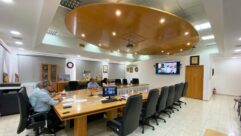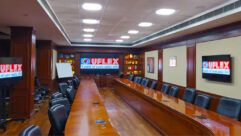Boardroom audio
May 1, 2000 12:00 PM,
Dale Florence
Although new video technology is often specified by the client for themodern conference room, achieving good speech intelligibility remainscritical to an installation’s overall success.
Today, customer expectations are high. Television and movies have setstandards of elaborate boardrooms and control centers where anyone intheworld can be seen, heard and communicated with by the press of a button orby a spoken command. Despite the fact that these types of representationsinvolve fantasy – perhaps including violations of the laws of physics butespecially regarding the budget for the room – business people have come toexpect this level of hands-free communication and ease of use in their ownoffice spaces, and they want you to design it.
Although technology is coming closer to meeting this promise, budgetrestrictions will continue to restrain full implementation of the newesttechnologies by all but the largest of corporations. Still, many boardroomshave complex, integrated systems consisting of multiple products, includingremote control, audio, video and data-sharing components. Boardrooms,however, are for communications, and at the heart of every communicationsapplication is the audio system. Even the most simple boardroom design willhave some type of audio requirement. With this in mind, we will focus onthe basic elements of a boardroom sound system and how best to meet thecustomer’s needs.
The first step in meeting the needs of a customer is to find out how he isgoing to use the system and what performance level is expected. If anarchitect or acoustical consultant is designing and specifying the system,most of this work will be done before the contractor becomes involved, butwe will assume that you get a call from a small- to medium-sized businessthat wants to build a boardroom or add audio to an existing meeting roomwithout going to an architect or consultant. This is the time to help yourcustomer define the scope of the project.
Next, identify the customer and his expectations. Set up a meeting with thecustomer to discuss the project. Talk to the individuals who will use theroom as well as the technical staff that will be involved with theday-to-day use and operation of the system. Each will have a different ideaof what is wanted from the system. Resolve any unrealistic expectations andhelp the customers determine what they actually need. Ask a lot ofquestions up front.
Additionally, knowing how the room will be used is absolutely necessary inorder to design and install a system that will meet the customer’s needs.How big will it be? How will it be built? What are the walls, floors andceilings made from? Is it a multi-purpose room? Can the room be dividedwith multiple meetings taking place simultaneously? What kinds ofpresentation media will be used? Will they be using remote conferencing?What about video? Common uses include playback of prerecorded A-V sources,viewing satellite or TV programs, speech reinforcement within the room, andteleconference or videoconference sessions. Suggest uses from yourexperience to make sure the customer is not forgetting importantapplications.
If you are installing in an existing room, be sure to check it outcompletely. If the room exists on the drawing board, talk to the architectand designers. One of the first principals of working with sound is knowingthe distance that it has to travel. Is sound reinforcement necessary?Remember basic principals; for example, how many loudspeakers will beneeded and what their best placement should be. A room with a low ceilingwill usually require more loudspeakers than a room with a higher ceiling toensure sufficient coverage. Surprisingly, medium-sized boardrooms oftenhave better acoustical properties than smaller or larger rooms.
Existing boardrooms or offices to be converted for boardroom use willlikely have wall surfaces made of plaster, gypsum board or paneling withcarpeted floors and acoustical ceiling tile. Newer boardrooms willincorporate modern designs featuring glass walls, marble floors, highceilings and large, hard-surfaced tables. Each of these surfaces absorbs orreflects sound waves in different ways.
The absorption characteristics vary in relation to the wavelength of thesounds in the room. Reflections can cause sound waves to combine slightlyout of phase and cancel each other out, causing dropouts or dead spots inthe room. Sound waves can also combine in phase and cause the system tobecome unstable, which leads to feedback or hot spots where the sound ismore concentrated. In addition, sound waves can bounce back and forthbetween flat, parallel wall surfaces and create standing waves at theresonant frequency of the room, which produces unwanted acoustic energy.
Eventually, all the reflections in the room will become incoherent and outof phase. Reflections and standing waves combine to form acoustic energycalled reverberation. As reverberation increases, intelligibilitydiminishes, and people in the room will be able to hear but not understandwhat is being said. When a person cannot understand speech, his or herfirst impulse is to turn up the volume, which only adds to thereverberation problem. In this case, turning the volume down a little maybe all that is necessary to bring back intelligibility.
Aesthetics vs. acoustics
Architects and interior designers strive to satisfy their customers bycreating rooms with high-gloss aesthetics and stunning visual effects.These rooms may look great, but hard surfaces inherently have pooracoustics. Curved walls and domed ceilings cause the biggest problems ofall. Curved surfaces tend to focus sounds to particular places in the room.If the focal point occurs at a mic, feedback will be an inevitable reality.
Acoustical treatment may be necessary if echoes, reflections orreverberations render the sound system ineffective or counterproductive.Absorption panels can be added to walls to reduce reflections andreverberation. Draperies can be placed in front of windows and glass walls,which can normally be left open but must be pulled closed during meetingsto provide a more cooperative acoustical environment.
A dollar spent improving room acoustics may save many times the amountrequired to overcome poor audio quality electronically. Plan in advance toovercome poor room acoustics. Explain both the problems and the possiblesolutions to the customer. Whether the boardroom is being newly constructedor remodeled, addressing acoustical concerns before work begins can preventa lot of unnecessary frustration and expense for customers and contractorsdown the road. Compromised acoustics require an optimized audio system thatwill be more complex and expensive. If the customer cannot afford thesystem, the sale will be lost.
Consider the room layout. How flexible is the room? Can it be sub-dividedfor simultaneous meetings? Ask about furniture arrangement in relation tohow the room will be used. Make sure to note the location of tables andchairs, and be prepared to make suggestions. Be sure to take multiple-uselayouts that might preclude having tables in fixed locations into account.
Next comes local speech reinforcement. Amplification of speech thatoriginates within the same room is considered local speech reinforcement.The goal is not to make speech louder but to extend the speaker’s voice toevery participant in the room. Someone who is seated on the last row of ameeting room should be able to hear the person speaking just as easily assomeone seated on the front row.
Most small boardrooms do not need local speech reinforcement simply becausemeeting participants are seated relatively close to each other. Someboardrooms, however, may require amplification because of their size or theacoustics of the room. In addition, speech reinforcement might still berequired for meetings that include people at distant sites or to reachpeople seated in another room set up to accommodate overflow attendance.Again, we are talking about extending the audio rather than making itlouder.
Mics in the boardroom
Simply stated, mics should be placed close to the person talking. Althoughthis statement may seem obvious, it is one of the most significant factorsin determining the performance of the audio system and one of the biggestchallenges for sound contractors. We have not yet found a mic on the marketthat can discriminate between sound from the person speaking and othernoise in the room. As a mic is moved farther away from the person speaking,the loudness of the speech reaching the mic is decreased. To compensate forthe loss in volume, mic gain must be increased, which leads to a greaterpossibility of feedback and will amplify background noise as well. Finally,the farther away the mic is from the person talking, the more hollow anddistant the audio will sound.
Because they can be closer to the person speaking, tabletop mics willgenerally do the job better than ceiling mics. The biggest problem withtabletop mics is that they are in the way. Place tabletop mics so thatpapers and charts will not interfere with the path of sound between the micand the person speaking. There are some imaginative table designs thataccommodate mics as well as a variety of other must-have electronics, suchas network access for laptops.
Customers often demand ceiling mics. Make them aware of the issues. Inaddition to problems created due to the distance from the person speaking,mics that are mounted directly to the ceiling can pick up rumbling soundsfrom vents and air-handling equipment. Although ceiling mics can work, theacoustical treatment required may not be worth the tradeoff. Hanging micscan work in rooms where furnishings need to be moved around for differenttypes of meetings. Be sure that hanging mics are not in the direct path ofsound from nearby ceiling-mounted speakers.
Critical distance must also be considered when locating mics. Criticaldistance is the point where the loudness of a person’s voice is equal tothe loudness of reverberant sound in the room. The critical distance of aroom is unique to the room and its acoustics. Measuring reverberation andcalculating critical distance requires special test equipment. Althoughspace does not permit a complete discussion of critical distance here, ageneral rule is to provide a good acoustical environment with mics locatedas close as practical to the person speaking.
More mic tricks
An automatic mixer should be used to turn mic inputs off and on as needed.An automatic mixer’s gate inputs open when the incoming signal reaches afixed or predetermined threshold. In practical terminology, this means thatthey turn the mic on when someone is speaking then turn it off when theyare quiet. This minimizes mics’ picking up HVAC or other constantbackground noise. The best automatic mixers also compare all of the micinputs in relation to each other and in relation to noise in the room. Ifthe signals picked up by all of the mics connected to the mixer (such asbackground noise) are equal, then the mixer will keep the inputs gated off.
Turning on additional mics will increase the potential for feedback.Automatic mixers can use the number of open mics as a reference tocompensate for feedback considerations. As the number of open micsincreases, the output level of the mixer is turned down. Doubling thenumber of open mics requires an overall reduction of 3 dB at the mixer’soutput.
Electronic feedback eliminators, EQs or other types of signal processorscan be used to achieve maximum gain before feedback in the audio system. Becareful to avoid over-equalization. Too much tweaking can result inunnatural sound and listening fatigue for the occupants of the room.
Other issues
Use data sheets, manuals and tech notes from loudspeaker manufacturers todetermine loudspeaker placement in the room. This will ensure adequatecoverage of all seating areas. Choose power amps to match loudspeaker loadrequirements. Overrate the amp power 20% to 30% to provide headroom forpeaks in audio level. This will prevent overdriving and clipping of theamp’s output signal and allow for better dynamic range.
As we extend the audio to all of the participants, do not forget thehearing-impaired. Assistive listening systems (ALS) should be includedunder the guidelines of the Americans with Disabilities Act. Generally,this requires assistive listening for 4% of the total seating capacity inrelation to the maximum seating for any use of the room. For rooms seatingless than 50 individuals, no less than two ALS-equipped seats are required.Assistive listening is usually accomplished with a wireless mic ortransmitter and a personal receiver for hearing-impaired individuals.Remember that radio transmitters and wireless mics can transmit signalsbeyond the confines of the boardroom.
Program audio
Audio from sources other than speech reinforcement, teleconferencing orvideoconferencing is often referred to as program audio. A program audiosystem is usually the easiest to design and install in a boardroom. Audiotape, CD, VCR, DVD and telephone, television or satellite audio needs to beheard by everyone in the room. This may require a high-end reproductionsystem, perhaps even surround sound.
If possible, design a program audio system that can be used independent ofspeech reinforcement and teleconferencing systems. Separate systems cansimplify control and provide a better S/N ratio and an increased frequencyresponse.
Choose professional-grade playback devices, rather than consumer-gradetypes, for best audio quality. The higher output levels from pro-audiodevices will allow inputs of mixers or switchers to be used at unity gain.Adding gain at input stages not only increases the program audio level, butit also amplifies any noise or distortion. Try to keep levels throughoutthe system at unity gain until the final power amp.
Use loudspeakers of good quality, matching the power amp to theloudspeaker’s power handling characteristics. For surround sound, considerusing a matched system of amps and loudspeakers supplied by onemanufacturer. For best results, follow the manufacturer recommendationsregarding loudspeaker placement and system connections.
Teleconferencing
Teleconferencing requires two-way communication. The local audio needs tobe extended to a far site, but the far end audio needs to reach the localsite as well. A telephone line can connect the sites, but the send andreceive audio exist on the same pair of wires. Routing a portion of thetransmit signal back on the receive path is called side tone or line echo,and on a regular telephone handset, it is desirable. Hearing yourself onthe earpiece helps determine how loud you should speak.
Now, connect the same phone line to the input and output of a sound system.What happens? The local audio is applied to the phone line; far end andlocal audio is brought into the system. The result is instant echo – if notsevere feedback. A telephone interface device called a digital hybrid isrequired to remove echo of this type. The digital hybrid samples the localaudio before it gets to the phone line. The sampled audio is then inverted180 degrees and combined with the audio from the phone line before beingsent to the amp and loudspeakers in the local room. Because the sampledlocal audio is 180 degrees out of phase from the original local audio, thetwo signals cancel each other out.
Digital hybrid telephone interfaces can be purchased separately andintegrated into the system in order to teleconference with more than onedistant site at a time. Some echo cancellers have the digital hybrid builtin, eliminating the need to purchase a separate component.
We have fixed the phone line issues, but we now have audio from the far endpassing through the amp to be heard from the loudspeakers in the localroom. Everything is great, right? Wrong. The audio from the loudspeakerswill be picked up by mics in the local room and sent back to the far end.The far end will hear an acoustical echo that is generated in the localroom.
Acoustic echo cancellers are used to sample the audio from the far endbefore it gets to the local amp and loudspeakers. Local audio, picked up bymics in the room, contains audio from the person speaking in the room aswell as far-end audio emanating from the loudspeakers in the local room.The sampled far end audio is applied, 180 degrees out of phase, to theaudio picked up by the mics. This cancels out the far end audio before thesignal is sent back to the far end.
The digital signal processors that exist in the echo canceller allow forsimultaneous local speech reinforcement and teleconferencing. Because thefar-end audio has been sampled and removed from the mic audio, the portionof mic audio containing only local talkers can be sent to the amp andloudspeakers in the local room.
A successful conference requires clear audio. What if you are working witha spectacular boardroom – that is, one with glass walls, marble floors anda hard table? You need conferencing equipment that optimizes audioperformance to deal specifically with these acoustical challenges.
Distributed echo cancellers have a separate echo canceller on eachindividual mic input, which enables each echo canceller to converge at afaster rate to quickly eliminate the echo. Changes in audio levels, micplacement and room acoustics are instantly accommodated. Some echocancellers have an automatic mixer built into them. All audio signals areconverted to digital information before any sampling, echo cancellation ormixing takes place. Because the mixer is an integral part of the echocanceller, the mixer’s inputs can be set to respond only to a voice in theroom. The automatic mixer can then ignore any and all audio from theloudspeakers. In addition to providing hands-free teleconferencing, thisfeature greatly enhances local speech reinforcement. Saving the expense ofa separate automatic mixer is another benefit of using combination echocanceller or auto mixer devices.
Two separate rooms require two separate acoustical echo canceling products.The reference for each echo canceller is based on its own room. Ininstances where moveable walls or partitions installed between two roomsare opened to create one large room, that room will require only a singleecho canceller. Rather than installing two separate distributedecho-canceller products, choose one that has two references. For combineduse, route all of the mic inputs to use one reference. For two-room use,route half of the mic inputs to use one reference and half to use thesecond reference.
Clearly, audio is only one part of designing a great boardroom. When youthink about why people meet, however, it is obvious that it is the mostimportant. If the projector fails, you can always describe the chart. Ifthe video blinks out, you can cope. Without audio, communication breaksdown, and you no longer have a meeting.
No one needs to feel intimidated by the prospect of providing excellentboardroom audio systems. The variety of available equipment offerssolutions to a variety of challenges; knowing what to plan for is thebiggest hurdle. In many ways, great boardroom audio has never been easier.










